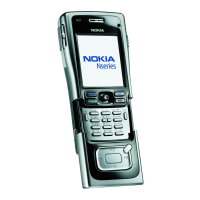Tools
94
Copyright © 2006 Nokia. All rights reserved.
Packet data
Follow the instructions from your service provider.
Access point name (for packet data only)—The access
point name is needed to establish a connection to packet
data networks. You obtain the access point name from
your network operator or service provider.
User name—The user name may be needed to make a data
connection, and it is usually provided by the service
provider. The user name is often case-sensitive.
Prompt password—Select Yes if you must enter a new
password every time you log in to a server, or if you do not
want to save your password in your device.
Password—A password may be needed to make a data
connection, and it is usually provided by the service
provider. The password is often case-sensitive.
Authentication—Select Normal or Secure.
Homepage—Depending on what you are setting up,
write the Web address or the address of the multimedia
messaging centre. Complete the Advanced settings to
further define your access details:
Network type—Select the Internet protocol type to use:
IPv4 settings or IPv6 settings. The other settings depend
on the selected network type.
Phone IP address (for IPv4)—Enter the IP address of your
device.
DNS address—Primary name serv.:, Second. name
server:. Contact your Internet service provider to obtain
these addresses.
Glossary: The domain name service (DNS) is an
Internet service that translates domain names such
as www.nokia-asia.com into IP addresses like
192.100.124.195.
Proxy serv. address—Define the address for the proxy
server.
Proxy port number—Enter the proxy port number.
Packet data
The packet data settings affect all access points using a
packet data connection.
Packet data conn.—If you select When available and you
are in a network that supports packet data, the device
registers to the packet data network. Also, starting an
active packet data connection is quicker (for example,
to send and receive e-mail). If you select When needed,
the device uses a packet data connection only if you start
an application or action that needs it. If there is no packet
data coverage and you select When available, the device
periodically tries to establish a packet data connection.

